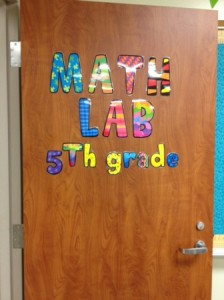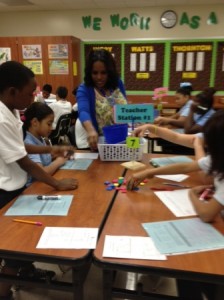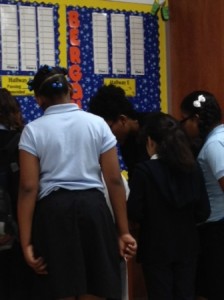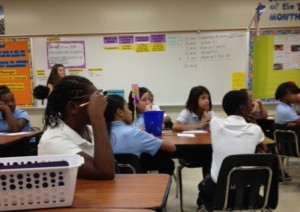“If I had thought about it, I wouldn’t have done the experiment. The literature was full of examples that said you can’t do this.” -Spencer Silver (inventor of Post-it adhesive)
People typically don’t read long blogs. But, this one is well worth the read! A few weeks ago, I had the incredible opportunity to visit a school who took a team of teachers who have used the Tabor Rotation Framework for a semester, a couple of available classrooms, an enthusiastic math specialist, a supportive administrative team, a little bit of time, a little bit of sweat, and…created a Math Lab!
Their information is worth thinking about and trying, so the formula for this blog post is simple. If one picture is worth a thousand words, then the pictures that follow should offer exactly what you need to get you started in putting a math lab in your school. This blog post may be longer in length, but keep scrolling down!
Approximately 3-4 weeks in advance, teachers plan for the content of a week using Tabor Rotation. They base their plans on Pre-Assessments and on-going assessment via Clipboard Cruising. This Planning for Tabor Rotation Sheet is an example of what they use to assist them in long-range planning.
While the rest of the class is working on exercises in computational proficiency and basic fact memorization, the teacher holds a Leadership Academy, with the Leaders and Co-Leaders of each team, at the back of the room. The Leadership Academy is the time when the teacher reviews how to complete the activities at the Games and Manipulative Stations. These activities have also been a part of the Whole-Group Mini-Lessons on Days 1 & 2 of Tabor Rotation, so this is a review and check for understanding with the leaders and co-leaders.
Not only do the Leaders and Co-Leaders have an important job in facilitating the learning taking place at the stations and keeping their teams on task, but Team Roles are given to every student so that each person is a vital and contributing member of the learning community.
The students work with partners as the teacher continues the session in the math lab with the Whole-Group Mini-Lesson. This Mini-Lesson is conducted with the entire class who is sitting next to their assigned partners. The teacher will pause every 3-5 minutes to encourage students to talk to their partner. This regular, planned Simultaneous Interaction helps students understand concepts and place them into short-term memory. It’s also extremely helpful as students share with each other and make connections to the concepts being explored.
The teachers at this school vary the modalities through which students learn concepts by having students rotate through the 4 Tabor Rotation Stations. They have arranged their desks in clusters to provide for as many as 36 students at a time in the lab. They even shared a copy of their Room Design and Rotation Plan in case you want to use it.

Teacher Time: The station that gives the teacher an amazing opportunity to work with ¼ of the class on the most difficult concepts for the week instead of trying to explain the most difficult concepts to the entire class at all at once.
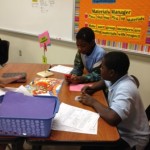
Games: The station in which students interact in a fun, competitive, and challenging medium to practice concepts.
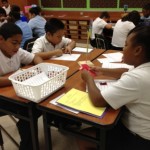
Manipulatives: The station that gives students a chance to explore and understand a concept concretely.
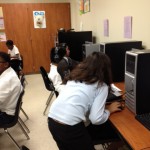
Technology: Computers and a Mimeo White Board help students practice a previously learned concept for intermittent reinforcement.
Some of you might be saying, “That sounds great, but how do I manage this type of instructional structure in my classroom or in a math lab?” This school has many Classroom Management tools to assist their students in being successful in learning math in a meaningful way.
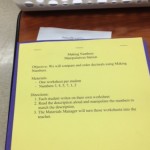
Every station has a leader folder with detailed directions on how to complete the activity, work the technology, or play the game.
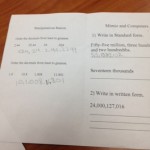
Exit Questions, checks for understanding, and journal writing are a part of the Passport given to each student to take with them to every station. This is also a great tool for individual accountability.
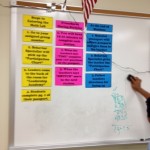
Just as science labs have specific rules for handling experiments and equipment, so do math labs.
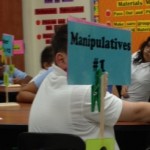
Signs with directions on where to move next really help the transition from station to station—especially when larger classes require two groups, or tables, at each station.

I can’t imagine a student not wanting to participate in the excitement and activity in a math lab, but if inappropriate behavior occurs, students are sent to complete boring worksheets at the Unfortunate Behavior Table.
The hum of productivity was everywhere in these labs and back in the classrooms as they continued doing what is best for all their students through Readiness Grouping on Days 4 & 5 of the Tabor Rotation Framework. That week, the teachers were sophisticating their use of Clipboard Cruising to provide for on-going assessment and to help them form the varied levels of readiness groups in their classroom. You might find this Tabor Rotation Readiness Grouping Spreadsheet useful as you plan for readiness groups in your classroom, too.
As we all know, every good team has an incredible coach and a spark plug to ignite us and inspire us. In the background, helping with the stations, you might be able to spot an additional adult in the room–she’s the math specialist for the school. When people visit to “see what has caused this school’s results to rise to the top in their district,” her roll is often misunderstood. Most have thought that the teachers bring their students to her and she does the rest. As she explains it, “this wouldn’t be optimizing the teacher capacity in our school.” Her true role is helping guide the team of teachers and the classes of students who use the math lab. She also facilitates the planning for Tabor Rotation, based upon regular pre-assessments, at least 3-4 weeks in advance. Attached is her job description as the Math Specialist.
As Agnes de Mille said, “The artist never entirely knows. We guess. We may be wrong, but we take leap after leap in the dark.”
Experiments and scientific labs have sparked imagination, curiosity, and amazing discoveries that have changed our world forever. Math labs have the potential to do the same thing. But, they are different than the traditional math classroom and trying them may feel like you’re taking a leap into the dark. A big THANK YOU to Marcella Intermediate for sharing their story and for lighting the way for others to take that “leap” into using math labs!


